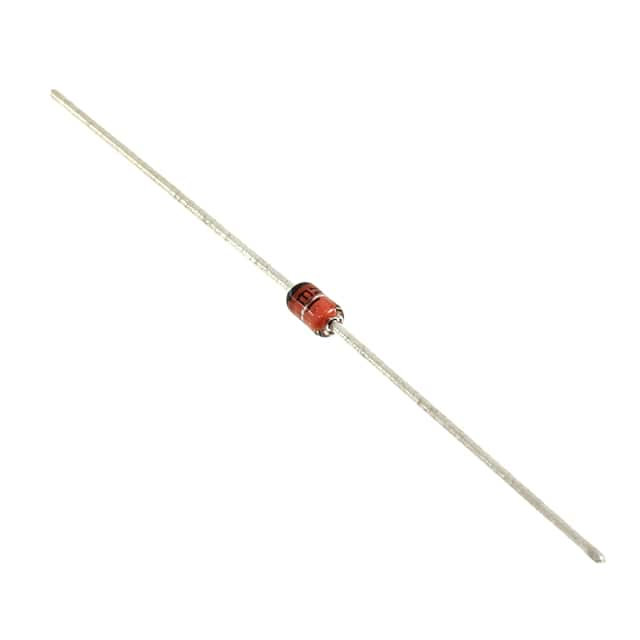Xem thông số kỹ thuật để biết chi tiết sản phẩm.

1N4731A_S00Z
Product Overview
Category
The 1N4731A_S00Z belongs to the category of semiconductor devices, specifically a Zener diode.
Use
It is commonly used for voltage regulation and protection in electronic circuits.
Characteristics
- Zener voltage: 4.3V
- Power dissipation: 1W
- Package type: DO-41
- Operating temperature range: -65°C to +200°C
- Packaging/quantity: Available in tape and reel packaging with varying quantities.
Specifications
The 1N4731A_S00Z is a silicon planar power Zener diode with a tolerance of ±5%.
Detailed Pin Configuration
The 1N4731A_S00Z has two pins, anode, and cathode, which are identified by the physical orientation of the diode within its package.
Functional Features
- Voltage regulation: The Zener diode maintains a constant voltage across its terminals, providing stability in electronic circuits.
- Overvoltage protection: It can protect sensitive components from excessive voltage by shunting excess current.
Advantages and Disadvantages
Advantages
- Precise voltage regulation
- Compact size
- Cost-effective solution for voltage regulation
Disadvantages
- Limited power dissipation capability
- Susceptible to damage from overcurrent conditions
Working Principles
The Zener diode operates in the reverse breakdown region, allowing it to maintain a constant voltage drop across its terminals when the applied voltage exceeds its rated value.
Detailed Application Field Plans
The 1N4731A_S00Z is widely used in various applications such as: - Voltage regulators - Overvoltage protection circuits - Power supplies - Signal clamping circuits
Detailed and Complete Alternative Models
Some alternative models to the 1N4731AS00Z include: - 1N4728AS00Z (3.3V Zener voltage) - 1N4735AS00Z (6.2V Zener voltage) - 1N4742AS00Z (12V Zener voltage)
In conclusion, the 1N4731A_S00Z Zener diode offers precise voltage regulation and overvoltage protection in a compact package, making it suitable for a wide range of electronic applications.
Word count: 311
Liệt kê 10 câu hỏi và câu trả lời thường gặp liên quan đến ứng dụng 1N4731A_S00Z trong giải pháp kỹ thuật
What is 1N4731A_S00Z?
- 1N4731A_S00Z is a Zener diode with a voltage rating of 4.3V, commonly used in electronic circuits for voltage regulation and protection.
How does 1N4731A_S00Z work?
- The 1N4731A_S00Z operates by allowing current to flow in the forward direction like a normal diode, but also permits it to flow in the reverse direction when the voltage reaches its breakdown voltage, providing a stable output voltage.
What are the typical applications of 1N4731A_S00Z?
- It is commonly used in voltage regulator circuits, overvoltage protection, and as a reference voltage source in various technical solutions.
What is the maximum power dissipation of 1N4731A_S00Z?
- The maximum power dissipation of 1N4731A_S00Z is typically around 1.0W.
What is the temperature coefficient of 1N4731A_S00Z?
- The temperature coefficient of 1N4731A_S00Z is approximately +2.0mV/°C.
Can 1N4731A_S00Z be used in reverse bias?
- Yes, 1N4731A_S00Z can be used in reverse bias to maintain a constant voltage across its terminals.
What is the forward voltage drop of 1N4731A_S00Z?
- The forward voltage drop of 1N4731A_S00Z is typically around 1.2V at a specified current.
Is 1N4731A_S00Z suitable for low-power applications?
- Yes, 1N4731A_S00Z is suitable for low-power applications due to its relatively low power dissipation.
What are the key parameters to consider when using 1N4731A_S00Z in a circuit?
- Key parameters to consider include its voltage rating, power dissipation, temperature coefficient, and reverse leakage current.
Are there any common pitfalls to avoid when using 1N4731A_S00Z?
- It's important to avoid exceeding the maximum power dissipation and operating beyond the specified temperature range to ensure reliable performance. Additionally, proper heat sinking may be necessary in some applications to prevent overheating.

